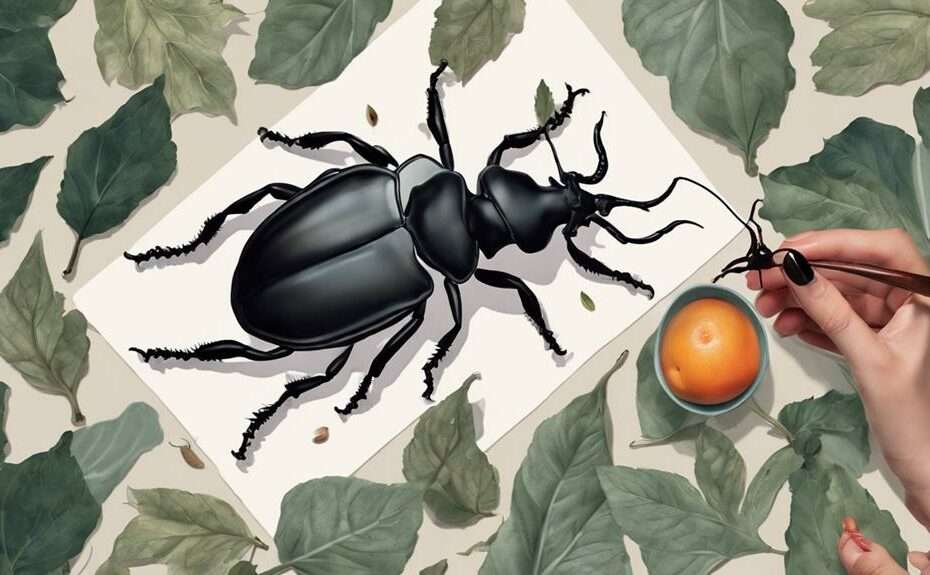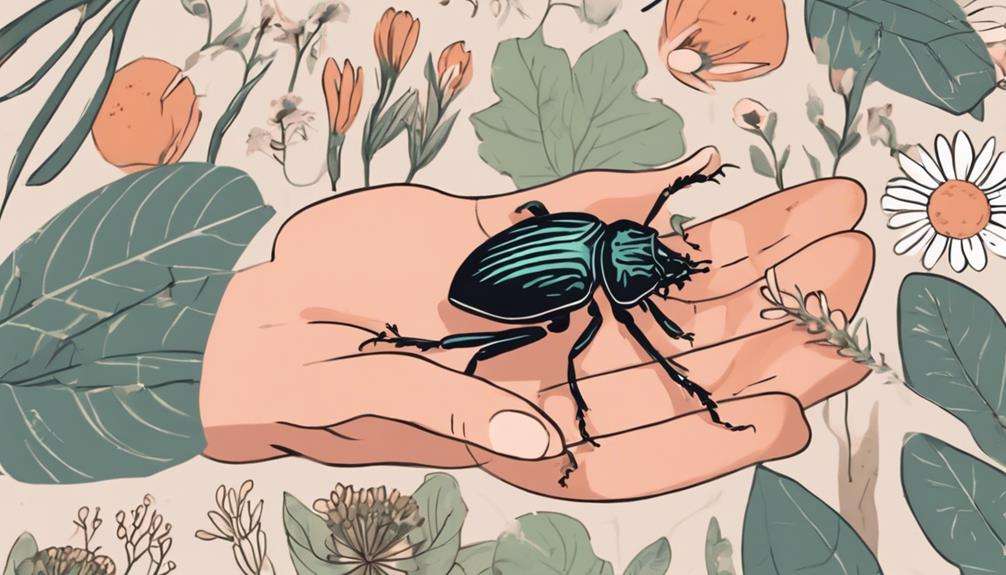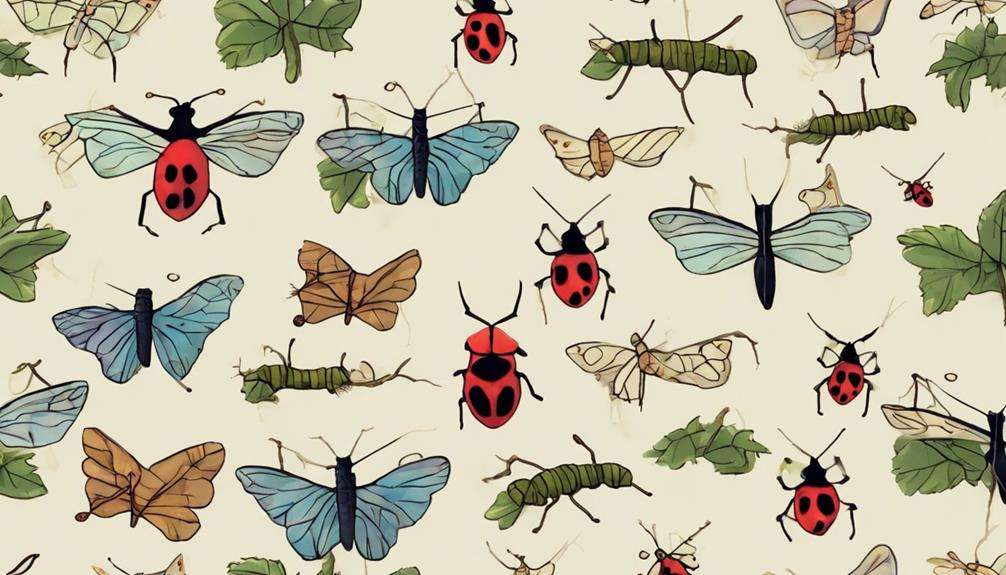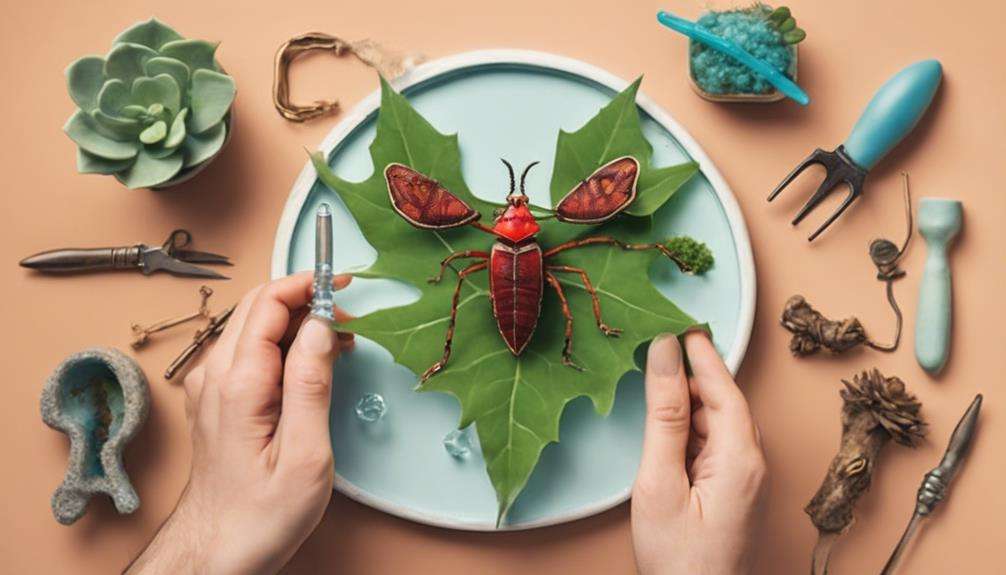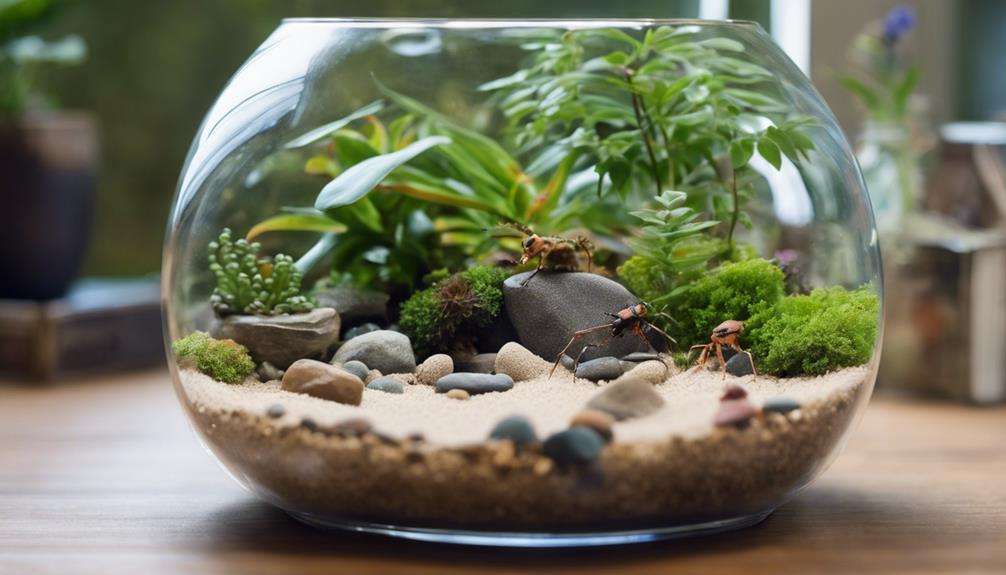If you've ever wondered how to keep your pet stag beetle healthy and thriving, ensuring they have a spacious and enriching habitat is just the beginning.
But what about the other key factors that contribute to their well-being? Stay tuned to discover the 7 best care tips that will help you become a knowledgeable and responsible pet stag beetle owner.
Key Takeaways
- Maintain proper humidity levels with suitable substrates.
- Provide optimal temperature and undisturbed breeding conditions.
- Offer a varied diet rich in fruits and commercial beetle jelly.
- Utilize resources for monitoring, care, and habitat setup.
Suitable Housing for Pet Stag Beetles
When setting up housing for your exotic pet stag beetles, it's important to make sure that the enclosure dimensions meet the minimum requirement of 30cm by 30cm by 30cm to provide adequate space for their movement and activities.
To create a suitable habitat for your stag beetles, consider using a glass terrarium, plastic box, or repurposed old aquarium with a customized lid to allow for proper ventilation. Adequate ventilation within the enclosure is essential to prevent moisture buildup, which can be detrimental to the well-being of your pet stag beetles. Customized lids should be designed to facilitate proper airflow while also preventing any escape attempts by the beetles.
Appropriate Substrate for Stag Beetles
When selecting a substrate for your pet stag beetles, consider using materials like coconut fibre or topsoil to mimic their natural habitat.
Ensuring the substrate contains decaying wood is essential for providing necessary nutrition and regulating humidity for the larvae.
Remember that substrates with white rot fungus aid in breaking down wood to support the survival and development of the larvae.
Ideal Substrate Types
For the best care of pet stag beetles, selecting an appropriate substrate is important to simulate their natural habitat and support their health and behavior. Stag beetles thrive on substrates such as coconut fibre, topsoil, or flake soil, which aid in moisture retention and provide a suitable medium for burrowing.
Including decaying wood in the substrate is essential for larvae nutrition and development. The presence of white rot fungus in the substrate is beneficial as it helps break down organic matter, which is important for the survival of the larvae.
Maintaining a substrate depth of at least 10cm (4') allows for burrowing and encourages natural behavior in stag beetles. Remember to keep the substrate moist but not waterlogged to guarantee the health and well-being of these fascinating creatures.
Moisture Level Considerations
Maintaining the appropriate moisture levels in the substrate is essential for upholding the health and well-being of pet stag beetles. Stag beetles require a substrate that retains moisture to mimic their natural habitat. Commonly used substrates like coconut fiber and topsoil help uphold suitable humidity levels.
It's important to keep the substrate moist but not waterlogged to prevent mold and bacterial growth. Incorporating decaying wood into the substrate serves a dual purpose by regulating moisture levels and providing a food source for larvae. Regularly monitoring the moisture levels in the substrate is necessary to ensure it remains conducive for stag beetles.
Substrate Replacement Schedule
Have you considered the prime replacement schedule for the substrate of your pet stag beetles to maintain a healthy and clean environment? It's important to replace the substrate every 3-6 months to establish a suitable living environment for your stag beetles.
The substrate mix should consist of coconut fibre, topsoil, and decaying wood to replicate their natural habitat effectively. Keeping the substrate moist but not waterlogged is essential for the larvae's development and to prevent dehydration. Regularly check for mold, pests, or unpleasant odors in the substrate, as these are signs that replacement is necessary.
Providing a deep layer of substrate, at least 10-15cm (4-6 inches) deep, allows the stag beetles to burrow comfortably and lay their eggs. This attention to the substrate will help maintain a healthy and thriving stag beetle environment.
Maintaining the Ideal Climate
Maintain the ideal climate for pet stag beetles by ensuring temperatures fall within the range of 18°C to 25°C without the need for additional heating sources. Stag beetles thrive in these temperatures without any extra assistance.
Proper humidity levels are also important for their well-being. Consistent monitoring of the enclosure's temperature and humidity is essential to create a suitable environment. Regularly check environmental conditions to guarantee they meet the beetles' requirements. Adjust humidity levels promptly to prevent dehydration or excess moisture, which can harm your pets.
Remember that stag beetles don't require any specific heating sources as long as the temperature remains within the recommended range. By maintaining these conditions, you'll provide a comfortable habitat for your pet stag beetles. Remember that they aren't picky about their surroundings as long as the temperature and humidity levels are within the ideal range.
Feeding Your Pet Stag Beetles
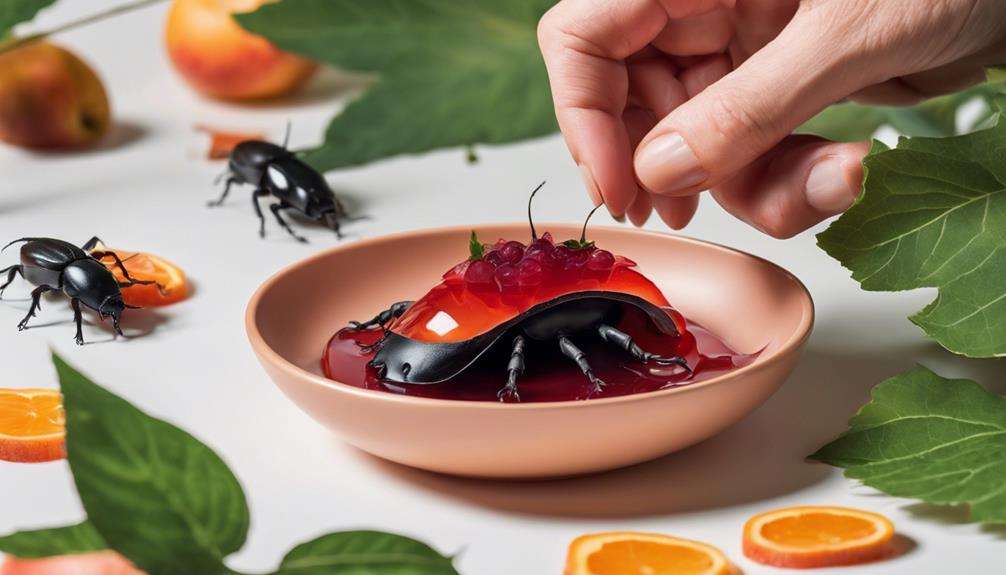
To guarantee the well-being of your pet stag beetles, provide them with a diet consisting primarily of fruit juice, tree sap, and specialized beetle jelly for essential nutrition. Offer a variety of fruits such as apples, mangos, bananas, and pears to make sure a balanced diet. Monitor the feeding frequency to prevent overfeeding and food spoilage. Maintain a consistent feeding schedule to meet the nutritional needs of your pet stag beetles.
It is important to store the food properly to maintain its freshness and quality. Avoid leaving food in the enclosure for extended periods to prevent bacterial growth and contamination. Regularly observe your pet stag beetles' feeding habits to adjust the quantities accordingly. Consider incorporating dietary supplements if necessary to enhance the nutritional balance of their diet.
Handling Stag Beetles Safely
When handling stag beetles, make gentle interaction to prevent stress or harm to the beetles. It's essential to understand their behavioral cues to make safe handling. Allow the stag beetles to walk on your hand voluntarily, as forcing them can lead to unnecessary stress. Communication signals from the beetles, such as mandible clicking or leg tapping, may indicate discomfort, signaling the need to adjust your handling approach. Avoid sudden movements or loud noises, as these can startle the beetles and cause stress.
Proper handling techniques play a crucial role in stress management and trust building. By practicing gentle interactions and respecting the beetle's boundaries, you can establish a positive relationship and build trust over time. Avoid exposing stag beetles to outdoor environments, as this can introduce potential dangers and additional stressors. Following these guidelines ensures the well-being and comfort of your pet stag beetles, fostering a harmonious bond between keeper and beetle.
Tips for Breeding Stag Beetles
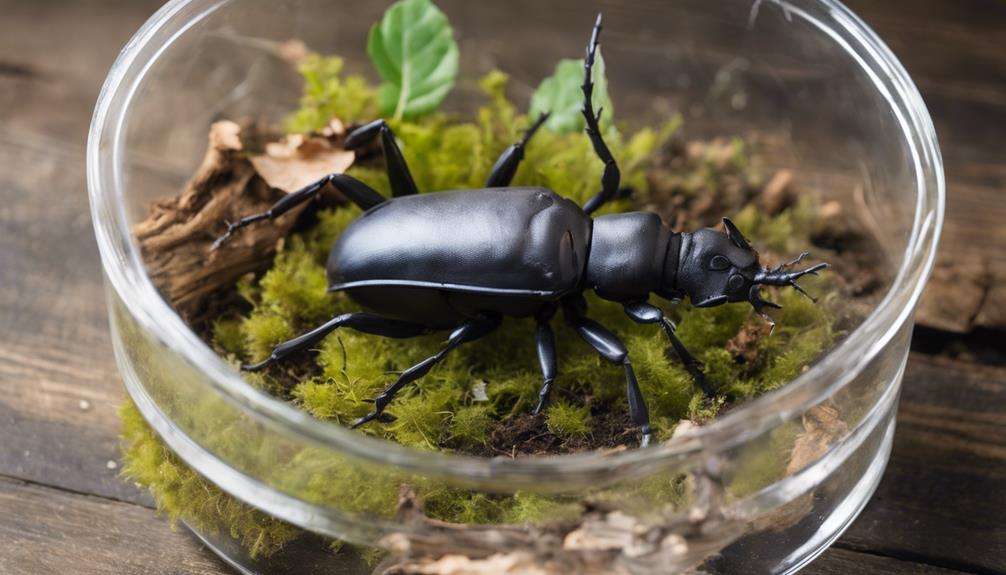
When breeding stag beetles, make sure to provide a separate enclosure for mating to prevent male aggression.
Offer decaying wood and soil for females to lay eggs, creating a suitable environment for larvae development.
Monitor larvae development closely, adjusting humidity and temperature for best breeding conditions.
Breeding Environment Setup
For perfect breeding success with stag beetles, make sure your setup includes a deep substrate layer of decaying wood and soil for the females to lay their eggs. Stag beetles exhibit fascinating nesting habits, with females preferring to lay eggs in a substrate rich in decaying wood.
Proper egg incubation requires maintaining suitable humidity levels in the breeding environment to support egg development. Understanding their breeding behavior is essential; males should be separated to prevent conflicts and guarantee successful breeding attempts.
Additionally, providing ample hiding spots and climbing opportunities for females is essential for them to lay eggs undisturbed. Monitor the breeding environment closely for signs of larval activity and adjust conditions as needed for the best development.
Feeding and Nutrition
To guarantee prime breeding success for stag beetles, maintain a diet rich in fruit juice, tree sap, and commercial beetle jelly for essential nutrition. Stag beetles exhibit specific feeding habits, primarily consuming fruits like apples, mangos, bananas, and pears to meet their nutritional requirements. These dietary preferences support their reproductive health, egg production, and overall vitality.
Offering a varied selection of suitable fruits ensures a balanced diet critical for healthy stag beetle development. Consistent feeding schedules play an important role in supporting breeding efforts and offspring viability. Adequate nutrition is fundamental for the well-being and successful breeding of stag beetles, highlighting the importance of providing the necessary food sources to sustain their growth and reproductive capabilities.
Monitoring Growth Progress
Maintain meticulous records of larval growth by closely monitoring size increase, molting stages, feeding habits, and any signs of abnormalities to secure high-quality development and breeding success in stag beetles.
To track growth accurately, employ growth tracking methods such as measuring the size of the larvae regularly using size observation techniques. Keep a keen eye on development monitoring tips by noting molting stages to assess growth progression effectively.
Record feeding habits and frequency to guarantee excellent nutrition intake for healthy growth. Additionally, document any abnormalities or signs of stress in larvae promptly to address potential issues and guarantee the well-being of your stag beetles throughout their development stages.
Essential Resources for Stag Beetle Owners
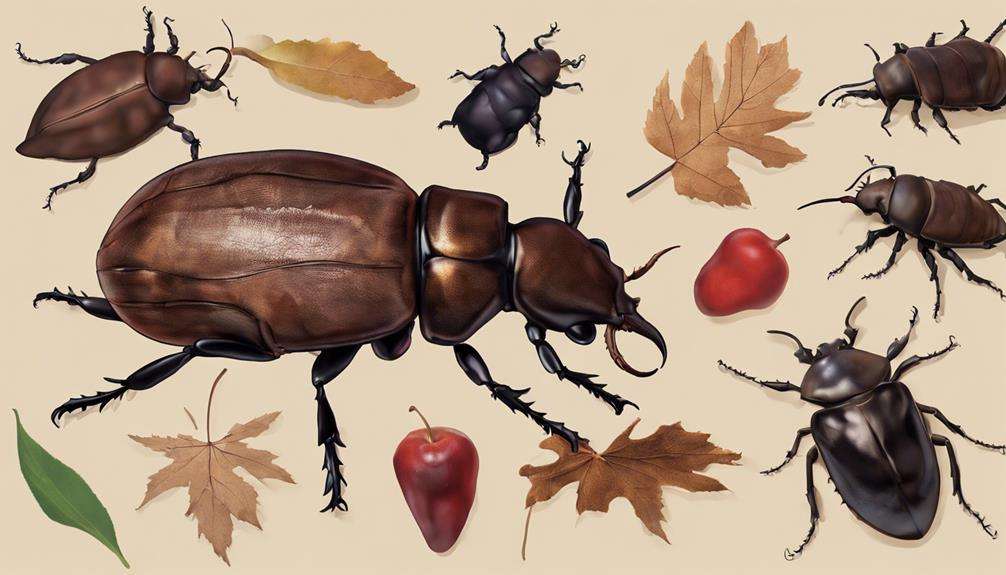
Important resources crucial for stag beetle owners include joining a community like 'Community for Reptile, Invert, and Amphibian Keepers' for valuable insights and support. Online communities offer platforms for sharing experiences, seeking advice, and accessing care guides specific to stag beetles.
The Stag Beetle Care Guide (Dorcus alcides) Wiki is a detailed resource providing information on habitat setup, maintenance, feeding habits, and breeding tips tailored to Dorcus alcides species. Understanding the specific habitat requirements, feeding habits, and breeding techniques is fundamental for the overall well-being of your pet stag beetle. By familiarizing yourself with these important aspects, you can guarantee a healthy and thriving environment for your beetle.
Additionally, accessing resources like the website Cookies Policy can enhance your online experience, providing additional information and support for researching and learning about pet stag beetles. Remember, proper care and access to resources are key to fostering a fulfilling relationship with your stag beetle companion.
Frequently Asked Questions
How Do You Keep a Pet Stag Beetle?
To keep a pet stag beetle, set up a spacious habitat with suitable substrates. Feed them a varied diet and handle them gently, letting them walk on your hand. Create a comfortable environment with proper temperature and humidity levels.
What Can I Feed My Pet Stag Beetle?
You can feed your pet stag beetle a diet consisting of fruit juice, tree sap, and commercial beetle jelly. Offer fruits like apples, mangos, bananas, and pears for their nutritional needs. Monitor feeding habits to guarantee a balanced diet.
How Do You Handle a Stag Beetle?
When handling a stag beetle, gently let it walk, avoiding sudden moves to prevent stress. Be cautious of their strong mandibles. Time spent handling should be monitored to avoid harm. Stay mindful, as they're nocturnal creatures.
Can You House Stag Beetles Together?
You can house stag beetles together, but avoid grouping multiple males due to potential conflicts. Consider pairing a male with females or multiple females to mimic natural breeding settings. Provide ample space and resources to prevent compatibility issues.
Conclusion
Concluding, ensuring the perfect care for your pet stag beetles is essential for their well-being and longevity.
Did you know that stag beetles can live up to 7 years in captivity if provided with proper care?
By following the guidelines outlined in this article, you can create a thriving environment for these fascinating insects and enjoy their presence for years to come.
Remember, attention to detail and consistent monitoring are key to the successful care of pet stag beetles.
